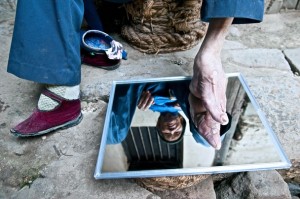
Source: Passarini, Mattia: “Last foot-binding,” 2013, Yunnan-China.
This image above, titled, “Last foot-binding” portrays an elderly Chinese woman from the Yunnan province with bound feet. One of her feet is dressed in a simple yet elegant maroon cotton lotus shoe. The left foot, however, is exposed to the photographer, unbound and bare. The unbound foot rests atop a square mirror, where the audience sees the reflection of the elderly woman’s face next to the view of the bottom of her foot. The photographer explains how, when this photograph was taken in 2013, less than 10 elderly women with binding feet were still alive in China.
The image exemplifies how perceptions of Chinese women with bound feet are limited and short-sighted. When viewing “Last foot-binding,” one can observe various signs upon conducting a deep connotative analysis of the image:
1) Age: The woman is one of the last surviving Chinese women with bound feet. Considering this, the image connotes the end of a time period and the end of a cultural phenomenon as represented through foot binding. Though this form of “fashion” may no longer be regarded as “in style,” it is important to note how the age of the woman exemplifies how this feminine fashion, bound feet, forcibly transcends time. For the woman in this image, bound feet are an unchanging part of her, coercively ageless despite changing fashion trends.
2) Contrast of the left foot to the right foot: The woman’s feet are contrasted to one another, the right foot covered while the left foot is bare, to show the permanency of the trend. In considering this contrast, one can also consider themes of secrecy and openness. Dorothy Ko in her article, “A Bondage in Time,” explains how foot binding once embodied and air of mystery. The image acts to uncover the mystery, while still hinting towards the enigmatic nature of the trend.
3) Clothing: The style of clothing that the elderly women wears is comfortable, casual, and worn down. Ko explains how the meaning of foot binding changed throughout history as it was embodied by different socio-economic classes. The audience can consider the woman’s life, as image suggests that the woman did not live a life of leisure, but a possibly laborious life.
4) The mirror: The focal point of this image is the bare, exposed bound left foot. It is interesting, however, that Passerini would use a mirror to reflect the elderly woman’s face slightly to the left of the focal point. The reflection of the woman’s face causes the audience to consider the woman as a separate entity from the bound foot. Her face is one piece of the image, while her feet are a separate part of the image, unattached to one another, yet still connected. The image acts to alter one’s perception of foot binding and perception of Chinese women as being defined physically, mentally and spiritually by foot binding.
The image ultimately causes the audience to reflect on their own conceptions, knowledge, and even apprehensions toward foot binding by adding a personal and human element to the image.
-Sarah persuasive analysis. the photographic design/manipulation could be further addressed
